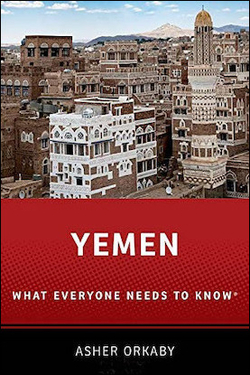 The author, a young scholar at Princeton University, disdains non-specialists on Yemen ("most Westerners," he notes, "can scarcely find [it] on a map"), and he rejects nearly everything that we think we know about the current situation (i.e., who is making war on whom, the nature of the Houthi movement). Orkaby is also fiercely protective of Yemenis, to the point of apologetics:
The author, a young scholar at Princeton University, disdains non-specialists on Yemen ("most Westerners," he notes, "can scarcely find [it] on a map"), and he rejects nearly everything that we think we know about the current situation (i.e., who is making war on whom, the nature of the Houthi movement). Orkaby is also fiercely protective of Yemenis, to the point of apologetics:
Rather than be defined by violence and fighting, tribal life is a rich cultural experience. Communal dances, poetry recitations, religious education, and the elaborate celebrations of life milestones and holidays are important parts of idyllic tribal life and manifestations of Yemen's rich cultural and social history.
Idyllic?
Fortunately, Orkaby himself provides the evidence to refute such silliness. For example, he writes,
As late as 2010, the Yemeni government continued to perpetuate the false generalization that their country has no ethnic groups and is entirely homogenous, when in fact Yemen has longstanding and institutionalized racism based on loose historical backgrounds and skin color.
Despite these drawbacks, Yemen has much to teach the non-specialist. How many readers know about the Salafi school in Dammaj, the Hashid and Bakil tribal confederations, the vital function of flash floods in Yemeni agriculture, the key role of Stafford Bettesworth Haines, the Famous Forty, the akhdam slave class, or the coffee beverage called qishr? This reader learned that the Hadramawt region has just 1.2 million inhabitants, but its diaspora is ten times larger (making it a Middle Eastern version of Ireland) and was surprised to realize the Mutawakkilite Kingdom of Yemen's declaration of independence on October 30, 1918, made it the first modern Arab state to proclaim itself sovereign.
Turning to the current civil war and the desperate humanitarian situation accompanying it, Orkaby proves a reliable guide to its complexities, pointing out important but little-known facts, such as the country's dependence on imports for 90 percent of its wheat and 100 percent of its rice.
As befits a book of this description, it has no overarching thesis but contains a compendium of useful information, using OUP's "what everyone needs to know" model of short questions and long answers. While some questions are a bit obvious ("Is there a social hierarchy in Yemeni society?") and the information somewhat random, reading through the volume leaves the reader with a sense of Yemen's history and culture, one of the world's more insulated and interesting.